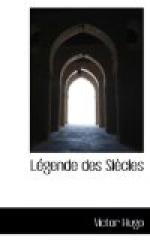La Nuit tire du fond des gouffres
inconnus
Son filet ou luit Mars, ou rayonne Venus.
Le Crapaud is wrapped in the light of sunset:
Le couchant rayonnait dans les nuages
roses;
C’etait la fin d’un jour d’orage,
et l’occident
Changeait l’ondee en flamme en son brasier
ardent.
* * * * *
Les feuilles s’empourpraient dans les arbres
vermeils;
L’eau miroitait, melee a l’herbe, dans
l’orniere.
And this because sunset is the hour for gentle thoughts and quiet feeling:
Dans la serenite du pale crepuscule,
La brute par moments pense et sent qu’elle
est soeur
De la mysterieuse et profonde douceur.
So strong is Hugo’s feeling for light and shadow that he often seems to solidify them, as it were, into concrete objects. When the trap-door in the hall of Corbus is opened
Il en sort de l’ombre, ayant l’odeur du crime,
and in the pit are seen
D’ombres tatant le mur et de spectres reptiles.
In Les Pauvres Gens
La morte ecoute l’ombre avec stupidite.
In Fabrice
L’aieul semble d’ombre et de pierre construit.
The light seems solid in this line from Le Satyre:
Son pied fourchu faisait des trous dans la lumiere.
Again, in La Conscience, shadow is vast and oppressive:
L’ombre des tours faisait la nuit dans les campagnes.
And in Au Lion d’Androcles it is the fitting emblem of the human race in a degenerate age:
La creature humaine, importune au ciel
bleu,
Faisait une ombre affreuse a la cloison
de Dieu.
Very curious is the connexion between the legends of a countryside and the smoke of its cottages in the lines:
Les legendes toujours melent quelque fantome
A l’obscure vapeur qui sort des
toits de chaume,
L’atre enfante le reve, et l’on
voit ondoyer
L’effroi dans la fumee errante du
foyer. (Eviradnus.)
Of the infinite variety of Hugo’s poetic gifts such a selection as is contained in this volume can of course give but a very inadequate idea. The extraordinary versatility and fecundity of his genius can be appreciated only by those who have read all, or at least much, of his output. But the first series of the Legende is perhaps that part of the poet’s work in which substance and beauty, original thought and vivid expression, are found in the most perfect combination. Written in middle life, it stands midway between his earlier poetry with its more lyric note and his later work with its deeper and more prophetic tones. In point of expression the poet’s powers had attained their full development; he has perfect command of rime; the versification is free and shows no trace of the stilted style of his first volumes; the language is copious and eloquent, but exhibits few signs of that verbosity and tendency




